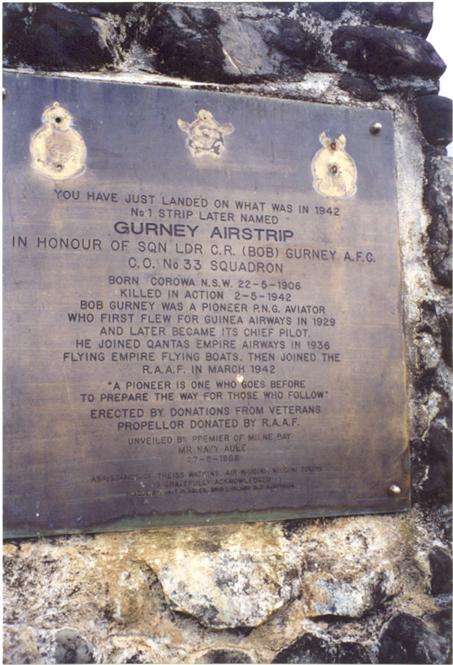Gurney Airport Memorial
Description
The memorial is an aircraft propeller atop a cairn, with a bronze plaque, situated at the entrance to the airport.
History
The Battle of Milne Bay was vital to the course of the Pacific War. The Japanese Military began its advance into the Pacific on 7th December 1941, when it attacked Pearl Harbour. Malaya, Dutch East Indies and the Philippines had already fallen to the advancing Japanese army. Rabaul, on the island of New Britain, was captured in January 1942, providing a sound and strategic base from which to attack the New Guinea Mainland.
After May 1942, General MacArthur ordered the airfield at Milne Bay when the Allied Forces won the Battle of the Coral Sea as a result of superior air power. This air power convinced the Allies to control the airspace around New Guinea and Northern Australia. Milne Bays' strategic importance to Australia and its allies was its location on the Eastern tip of the Papuan mainland. An allied base could safeguard and dominate the vital sea lanes to Australia and more importantly, the Eastern approach to Port Moresby. An airfield in this area would allow allied aircraft to operate over the Solomon Sea as far as Rabaul. It would also shorten the flying distance to the Northern Islands and increase the flying range, as flying out of Port Moresby required a steep climb over the Owen Stanley Ranges (7000 feet). For the Japanese army, it was seen as another route to Port Moresby and a way to isolate Australia and prevent Port Moresby being used as an allied base for counter-offensive against Japanese conquests.
In June 1942, Allied Army Engineers began work on the No.1 Strip (Gurney) as the first phase towards building Milne Bay into an offensive and defensive Allied base. Milne Bay featured in the master plan of the Allies as the staging point for the recapture of the Japanese occupied territories.
Gurney airport was named after a Second World War RAAF pilot, Squadron Leader Capt. Bob Gurney, who was the commanding Officer of the No. 33 Squadron. He joined the RAAF in March 1942 and was killed in action in May 1942. It is believed that his plane crashed somewhere in the Trobriand Islands.
Construction Information
No information available at this time.
Location
Milne Bay, Papua New Guinea.
Located at the entrance of the Gurney Airport, Milne Bay

